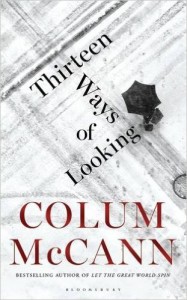Bloomsbury
November 2015
 Thirteen Ways of Looking is a book of three short stories plus a novella.
Thirteen Ways of Looking is a book of three short stories plus a novella.
The book was in the process of being written when the author, Colum McCann, was assaulted and hospitalised after he went to the aid of a woman who was being attacked by her husband. At the end of the book McCann invites readers to go to his website colummccann.com to read his Victim Impact Statement.
McCann’s stories of varying degrees of human suffering are never mawkish or laboured in their execution, but finely written and strangely uplifting. He has not, like some other authors, gone to the extremes of the human condition as an easy source of drama but, I think because he has the insight and skill to shine a light on it. The book is an attempt to connect us more with our fellow human beings rather than an exploitative romp through misery.
The novella comes first and follows, in minute detail, the events leading up to a violent assault on a retired judge and then deals with its aftermath. It is an almost second-by-second account of the events leading to the attack, from the moment the judge wakes in the morning, to the moment he is punched to the ground after leaving a restaurant where he was having lunch with his large and unpleasant son. The writing is elegant and evocative as it traces the indignities of old age and wistful thoughts of youth and first love. We see the judge re-live the important moments and people in his long life, before he dies. The message being, perhaps, that the final undignified moment does not spoil the life that went before.
The first short story is a short story about someone writing a New Year’s Eve short story…are you with me? We see the story of the female combat soldier on duty in Afghanistan as it forms in the writer’s mind. We are shown behind the curtain of the creative process. We see the piece of fiction being constructed. We are invited into see that it is, in fact, artificial. It is manufactured to get a certain reaction from the reader and to give the reader a certain experience. And yet, the story must seem real. It must seem to have been extracted fully formed from the experience and suffering of the author. It must feel as if it was a story that had to be told. A story that had escaped the confines of the author’s mind to live on the page so that others could know of it. The strange thing about this story within a story is that although I, the reader, was in on the process, the fiction still held true. I still wanted the good and satisfying ending that I could not have thought up for myself but was gratified when it came. I still thought Sandi was real and I cared about her. It was as if, step-by-step, a magician showed his audience how the trick was done but still, at the end, they applauded and said ‘now that was magic’.
The next short story tells of Rebecca, the mother of an adopted Russian orphan with foetal alcohol syndrome. On the west coast of Ireland the mother and son go swimming to try out his new wet suit. The next day, when he goes missing, Rebecca goes through the agonies of waiting to see if her son will be found while falling under suspicion of neglect from her ex-husband and worse from the police. The pain of waiting and self recrimination play out while Rebecca waits.
The last short story tells of a nun who sees the face of the rebel who raped and tortured her thirty years before. She relives the horror while trying to decide what to do about it. Should she track down the man and confront him? If so what would she say? All the while, she is imprisoned by her own Catholic faith. She punishes herself for not being able to fully forgive, for not having the humility to let go of the affront to her ego.
If the stories have a common thread I think it would be the impossibility of categorising the human condition, especially at times of suffering. There are no glib answers, not in religion, politics or psychology. Perhaps the stories show the importance of writing as eloquently as we can of the struggle to be fully human—to try, however imperfectly, to do the right thing even when things go horribly wrong around you.
If this was Colum McCann’s goal I think he achieved it. His skill with words coupled with his understanding of the human condition combined to tell sad but uplifting tales of human beings trying to find the strength to be kind when it would be easier not to. Colum McCann’s Victim Impact Statement showed his struggle to comprehend what had happened to him and to try to find the just and human response to the perpetrator. There are no glib conclusions there, just as there are none in his stories.

